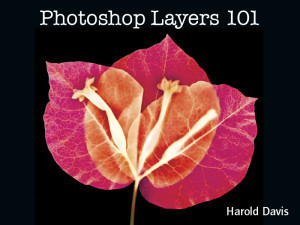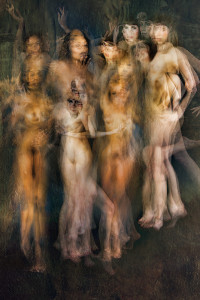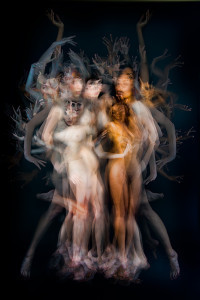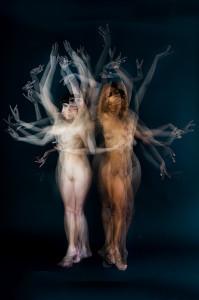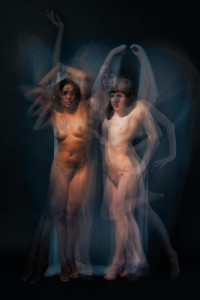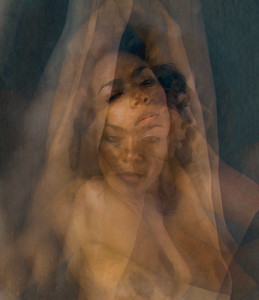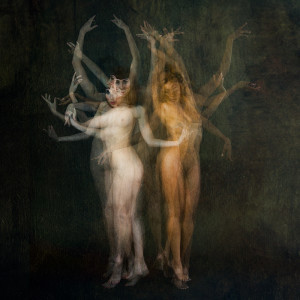Harold Davis's Blog, page 175
August 20, 2014
A Rorschach for MFA’s
This image, with the working title Gates after Rodin, shows one model many times. The model, Jacs Fishburne, is a self-described “tornado disguised as a woman.” In the studio, Jacs was posing on a large metal hoop, sometimes called a Lyra. The Lyra was suspended by two ropes about six feet above the ground, with a black background. For some of the exposures Jacs was kneeling on the ground “holding up” the Lyra.
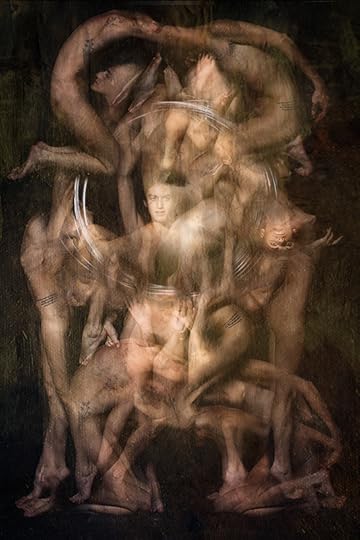
Gates after Rodin © Harold Davis
To make the image, I shot five in-camera multiple exposures, with Autogain turned on so that each multiple exposure was properly calibrated. Each of the multiple exposures consisted of five to eight individual shots, with Jacs changing her pose between each one. I used basic studio lighting for an even, consistent look and my D800 with the Zeiss Otus 55mm f/1.4.
I then combined the in-camera multiple exposures in Photoshop, using both stacking and selectively pasting bits from various versions in using layers and masking. By some ways of counting, this makes for a total of somewhere between 25 and 40 different captures of Jacs, when you multiply the number of files by the number of times she appears in each.
Before finishing the image by adding a texture, I retouched out the ropes from above holding the Lyra, leaving the circular Lyra mostly in place.
A friend writes: “It brings up associations with five or six classic paintings from earlier eras. I see the Winged Victory of Samothrace on the left, and the hand of the Sphinx on the center right. Cardinal Richelieu is in the center. The face in profile at the upper left comes from something I can’t quite place and the depictions of hell by the famous Dutch painter What’s-His-Name are at the bottom [Hieronymus Bosch]. And then there’s the hint of the sumi-e circle of light again [the Lyra]. It’s like a Rorschach for MFA’s! ”
My own association is with Rodin’s Gates of Hell. I saw a casting in the garden at the Rodin Museum in Paris this spring. Maybe the memory of the Gates was lurking in my subconscious, waiting for a chance to emerge!
Related story: Multiple Exposures.

August 18, 2014
Umbrellas, Tokyo
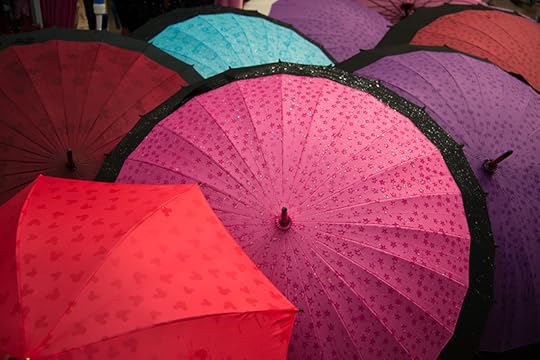
Umbrellas, Tokyo © Harold Davis
When it comes to photographic technique, sometimes simple is good. I photographed these umbrellas on the street in Tokyo in a light rain on a overcast but bright autumn day, handheld at 1/160 of a second, f/4.5 and ISO 400. There was no post-production involved other than a little adjustment in the RAW conversion.

August 17, 2014
Photoshop Layers 101 Recording Now Available
Photoshop Layers 101 Recording
The ability to work with layers and layer masks in Photoshop is what unlocks the power of Photoshop, and separates it from more mundane image editors. Yet many people find working with layers (and the tools related to layers) daunting, both conceptually and practically.
This webinar aims to get you over this learning hump gently. It is intended for serious photographers—for example, those working in Lightroom—who want to take their work to the next level in Photoshop. We will go slowly, work through many examples, and reserve ample time for questions
The Photoshop Layers 101 with Harold Davis webinar covers:
What is a layer?
Working with layers
Adjustment layers versus “regular” layers
Hide all layer masks
Reveal all layer masks
Viewing alpha channels
Opacity
Blending modes
Painting on a layer mask with the Brush Tool
Using the Gradient Tool
Here’s one comment from a viewer: “Layers used to scare me. Now, thank to Harold’s gentle approach, I can begin to unleash to full power of Photoshop!”
Another viewer adds, “I love your webinars!!!”
Click here to register for access to this webinar recording (unlimited access is $19.95).

August 15, 2014
Letter about the Photo Odyssey to Japan & Special Offer
I’ve been asked to explain by several people who are interested in my photographic trip to Japan why it is “so expensive.” You can find the full trip itinerary here, and trip costs with registration info here.
I have not created this trip as a money making venture—this trip is a matter of the heart for me that I would like to share with a select few. I have spent a huge amount of time planning this trip. I am eager to share the aspects of Japan that I love with other photographers. I’ve worked hard to keep the costs as low as possible, but some things—like being in Kyoto for cherry blossoms—are simply not about money.
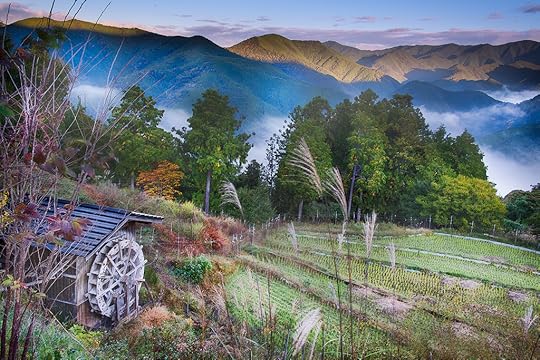
Dawn in the High Fields © Harold Davis
Essentially the old adage about getting what you pay for comes to mind, but let me be more specific:
Japan is an expensive place to visit.
There is a tremendous amount included in this trip. It runs for eighteen days. This is a long trip, it includes most meals, airfare from Hiroshima to Tokyo, a workshop at the fabled, 700-year-old Awagami Paper Factory on Shikoku Island, the hotels I really wanted (in Kyoto during cherry blossom season this is a big deal), many admissions (which in Japan really add up), all kinds of transport, and bilingual guides throughout. Please take a careful look at the itinerary to see all that is being offered.
The kicker is the small group size. Many things cost the same amount no matter how many people are in the group. This goes for guides, buses, and more. The more people, the lower the per-person cost. Of course, in a smaller size you also don’t get substantial group discounts.
Generally, I want to lead smaller groups when I travel with photographers, and it is a fact of life that this leads to higher costs. The point is a more personal experience, so that I can spend ample time in a collegial fashion with each photographer on the trip.
In the case of the Photo Odyssey to Japan, some of the very special places we will visit and stay at can only accommodate the smallest of groups. So if I wanted to present this fantastic trip, I had no choice but to keep the group size small. I do realize that not everyone is “made of money,” and I have worked hard to keep the costs as low as possible.
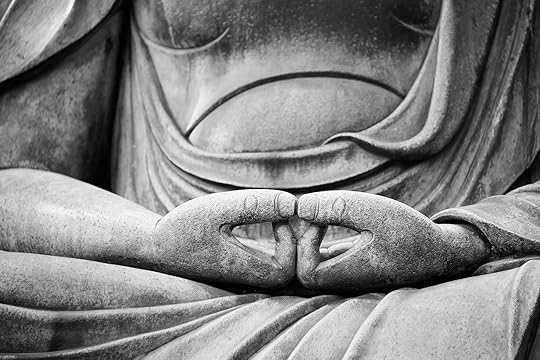
Buddha Samadhi © Harold Davis
If you take a look at the detailed itinerary, you will see that it is assembled with a great deal of care, and that those lucky enough to join us will have unique experiences, and come home with many great and unusual photos–not just the typical tourist photographs.
Now here’s the special offer. I am eager to get the Photographic Odyssey to Japan well-launched by the end of August. So this offer is intended for you, if you are sitting on the fence. If you follow the simple registration steps, fill out the registration application and pay the $500 trip deposit before September 1, 2014, I will send as a gift to you a signed, original 11″ X 14″ print of either Dawn in the High Fields, Takihara or Buddha Samadhi. The archival pigment prints are handmade in my studio on Awagami Kozo washi, and have a retail value of $495 each. The images are shown above in this story. (The Awagami Factory is where we will make paper on the trip!)
The fine print: There really isn’t any. If the trip doesn’t run, of course your deposit will be returned, and you can keep the print as my gift. If you have already signed up, of course you are entitled to your choice of either print.
So what are you waiting for?
Visit a Japan that most westerners never get to see with special, once-in-a-lifetime photographic opportunities.
Harold Davis
For the itinerary: www.digitalfieldguide.com/japan-workshop
To register: www.digitalfieldguide.com/japan-registration

August 14, 2014
Multiple Exposures
I feel like showing the six images in my Multiple Exposures series (at least so far there are six) in one blog story. Thanks Marianne for the great title suggestion for the sequence! The models are beautiful women, but multiply exposed like this there is something definitely off-balance and dark about the ensemble.
Les Demoiselles © Harold Davis
Being and Becoming © Harold Davis
Kali © Harold Davis
Earthbound Angels © Harold Davis
Passion © Harold Davis
Solace for the Wild Rest © Harold Davis
Related blog stories: When is a photo not a photo?; Multiple Exposures, Kali and Les Desmoiselles, Being and Becoming; Solace for the Wild Rest, Duos and Redos.
Also see Tender Dance and Sisters.

August 13, 2014
Los Gatos-Saratoga Camera Club Presentation on August 18
I will be presenting “Creative Black & White” at the Los Gatos-Saratoga Camera Club on Monday, August 18 2014 at 7:30PM. Here’s the event description:
Creative Black and White Photography—Harold is a leading contemporary photographer and artist who uses innovative technical processing techniques to create exquisite Black and White photographs. View some of his work at www.digitalfieldguide.com/galleries/black-white
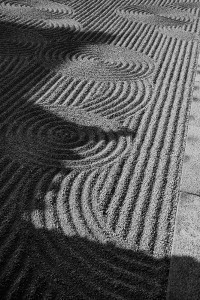
Temple Garden, Kyoto
Please keep in mind these other upcoming Bay area events (free or nominal cost at the door):
Tuesday, August 26 2014 at 7:30PM—Harold Davis presents “Digital Black & White” at the Alameda Photographic Society (click here to download PDF brochure).
Monday, September 22 2014 at 7:15PM—Harold Davis presents “Making Memorable Travel Photos” at the Golden Gate Computer Society
Tuesday, September 23 2014 at 7:15PM—Harold Davis presents “Photographing Flowers for Transparency” at the Peninsula Camera Club
Please click here for a PDF brochure of my workshops, and here for the calendar of events. Webinar recordings are available by clicking here.

August 12, 2014
Flowers for Nicky
My twelve year old son Nicky (shown here a while back) was in the ensemble at Berkeley Playhouse for a teen production of the musical Shrek. For opening night, his Grandma sent him flowers.
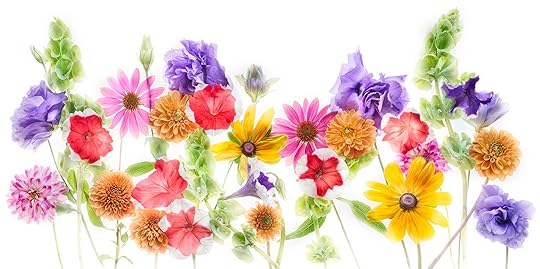
Flowers for Nicky © Harold Davis
He (and we) enjoyed the bouquet for a while. Then, a couple of days after the performance, I spread them out on my light box, and photographed the flowers for transparency.
For more information on my technique, check out my FAQ: Photographing Flowers for Transparency.

August 7, 2014
Sony Alpha a7R—Initial Impressions
I’ve been testing a new interchangeable lens camera, the Sony Alpha a7R, to see if I can happily use it. The a7R can truly be thought of as a new paradigm camera compared to the DSLRs I am accustomed to using, which are basically classic SLRs with an optical pentaprism and mirror, updated for digital. The full frame sensor in the a7R is the same as the sensor in the Nikon D800E (the Nikon sensor is made by Sony), with a full 36MP capture. This camera has great resolution, but no mirror or optical viewfinder—and weighs less than half of what a full-frame Nikon DSLR weighs.

Succulents (via Sony Alpha a7R) © Harold Davis
It’s really interesting how the gear we use influences our imagery, and even what we see and how we see it! I shoot differently with a full-frame DSLR than when using an iPhone camera, and as I try the a7R, I am working differently yet again—and taking different shots.
This is a very smart camera, and a magnificently designed machine. It is a real pleasure to hold in my hands, and the light weight of the form factor considering the resolution is nothing short of astounding.
I shot the image shown above with a Sony-Zeiss Vario-Tessar FE 24-70mm lens at 70mm, f/5.6, 1/80 of a second and ISO 100 handheld. It’s not my usual way of working, but I set the camera on Auto, and let the camera do the thinking about focus and exposure. It did a pretty good job, I’d say. Auto-pilot, when it is as good as the automation in this camera, has something to be said for it because I can concentrate on seeing, and I don’t need to think about the technical aspects. Maybe this is the future, a little like being driven by a Google car!
I’m continuing to work my way through the sketchy documentation, explore my feelings about the non-optical viewfinder, see how easy it is to use manual exposure settings, find out whether it plays well with my wonderful collection of Nikon-mount Zeiss glass via the Sony E to Nikon F metabones adapter, test battery life, see how I can use the a7R with an intervalometer, and investigate other issues.
I’ve added a tripod quick-release plate to the bottom of the a7R, and I will be using it this weekend as my primary camera as I lead a landscape photography workshop at Point Reyes National Seashore.
The questions I now need to answer for myself don’t really relate to the camera per se, which is clearly a magnificent machine, but rather to how well I work with it, and whether my style of craft meshes well with the machine. Camera and photographer are a kind of cyborg. Does this Harold-Sony a7R man-machine cyborg work and play well? Stay tuned.
Full disclosure: Sony kindly lent me the Alpha a7R along with the 24-70mm lens.

August 6, 2014
Riders on the Storm meets Christina’s World
In the surprising uplands of Dordogne and Lot in the southwest of France high alkaline plateaus are bisected by deep river valleys. You’ll find medieval towns and castles, with markers from the history of the bloody 100 years war. The Brits may not have conquered back then, but today they’ve taken over, with everything from modest vacation bungalows to gated chateaus and estates.
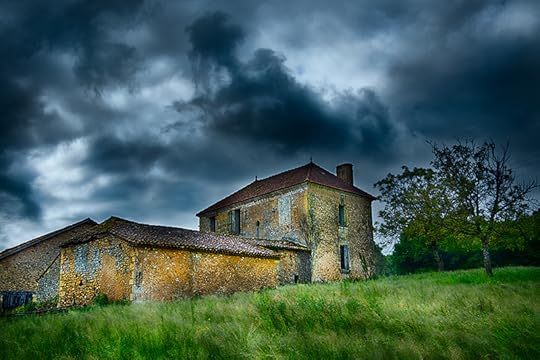
Riders on the Storm © Harold Davis
Exploring the back country, in the smallest hamlets I could find, were also abandoned farms and ruined buildings. I paused in Saint-Romain, ahead of the storm, to photograph this farm house, intricate in its construction and picturesque in its decay. The wind whistled through the grass in the fields, with a sound as desolate as the abandoned buildings. The only thing missing was Christina, I thought, disassembling my camera and tripod and turning away as the first drops of rain began to fall.

August 4, 2014
Trio of Tulips at Giverny
On a misty spring afternoon we left Paris, getting on the van for Monet’s famous gardens at Giverny. The pre-visualizations that I saw in my mind’s eye along the drive were of images like Monet’s impressionistic paintings, or that showed the bridges in the Giverny water gardens. But when we got to the garden the simplicity of individual tulips in the light rain was too much for me to resist!
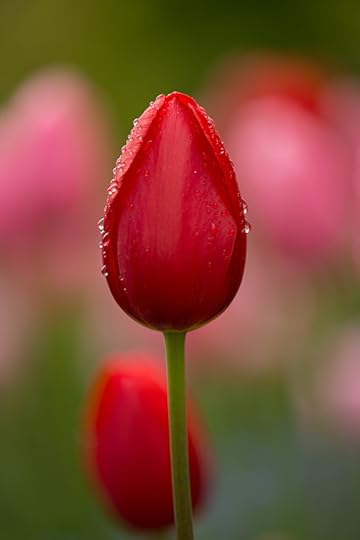
Red Tulip, Giverny © Harold Davis
The afternoon was cloudy, but extremely bright. I shot each of these three images handheld, wide-open (at f/2), with my ISO set to 100, taking advantage of the brightness and wonderful bokeh of the superb Zeiss 135mm f/2 lens. Shutter speeds were 1/1600 of second for Red Tulip (above), 1/5000 of a second for Variegated Tulip (below) and 1/8000 of a second for White Tulip (bottom). There was almost no post-production work other than RAW conversion.

Variegated Tulip, Giverny © Harold Davis
So ultimately this is one of the simplest photography scenarios imaginable. If there is no post-production, then Photoshop was irrelevant (not of course that there is anything wrong with Photoshop). The superb brightness of the lens along with its telephoto focal length isolated the portion of the flower that is in focus from the background. The brightness of the lens allowed me to shoot at fast shutter speeds, eliminating the possibility of camera shake. The technical requirement was to “see” the image, and to focus accurately—with nothing else intermediating between me and the flowers.
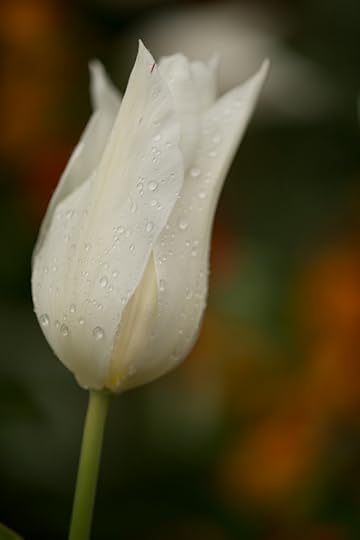
White Tulip, Giverny © Harold Davis
Sometimes in this complex world of ours it is hard to remember that simple may be best! When we over-complicate things we can lose track of what is important, and what is not—and also the joy in simple things, of family and friends, clouds and wind, and flowers in a garden.


